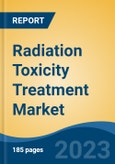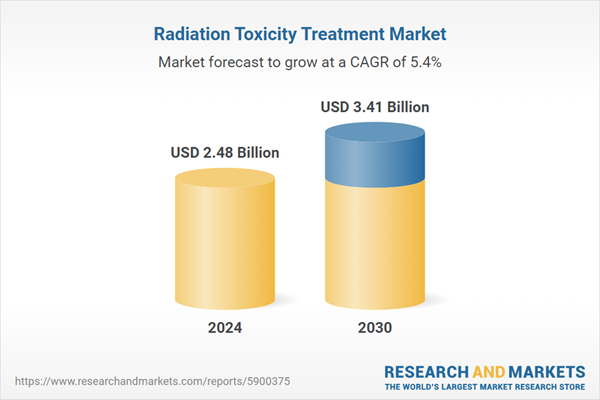Speak directly to the analyst to clarify any post sales queries you may have.
10% Free customizationThis report comes with 10% free customization, enabling you to add data that meets your specific business needs.
The primary drivers of this market's growth is the rising global cancer burden. As cancer incidence continues to rise worldwide, the number of patients undergoing radiation therapy has increased substantially. However, radiation therapy is not without its side effects, and radiation toxicity, including skin reactions, gastrointestinal issues, and organ damage, is a common concern.
This has spurred the demand for radiation toxicity treatment options, including pharmaceuticals, medical devices, and supportive care services. Pharmaceuticals form a crucial segment of the radiation toxicity treatment market, with drugs and medications developed to manage and alleviate the symptoms of radiation toxicity. These pharmaceuticals include anti-inflammatory agents, growth factors, and radioprotective drugs. Additionally, advancements in targeted therapies and immunomodulators hold promise for improving the effectiveness of radiation therapy while reducing associated toxicities.
Key Market Drivers
Increasing Cancer Prevalence
The escalating global incidence of cancer significantly propels the growth of the Radiation Toxicity Treatment Market. This surge in cancer cases leads to increased utilization of radiation therapy, consequently amplifying the demand for treatments addressing radiation-induced toxicities. Recent studies indicate a substantial rise in cancer cases worldwide. For instance, projections suggest in 2022, approximately 20 million new cancer cases were reported globally, resulting in nearly 10 million deaths. Demographic projections suggest that the annual incidence of cancer will rise to 35 million by 2050, representing a 77% increase from 2022 figures. This surge is particularly pronounced in low- and middle-income countries, where healthcare infrastructure may struggle to accommodate the growing burden.Key Market Challenges
Limited Awareness and Education
One of the primary challenges is the lack of awareness among patients undergoing radiation therapy. For many individuals diagnosed with cancer, the focus understandably shifts to the cancer itself and its treatment. Patients may not be fully informed about the potential side effects of radiation therapy, which can include skin irritation, fatigue, gastrointestinal issues, and damage to healthy tissues. Consequently, they may not actively seek information about radiation toxicity treatment options that could mitigate these adverse effects.This lack of awareness can lead to suboptimal patient experiences, as individuals may not be proactive in discussing radiation toxicity concerns with their healthcare providers. As a result, they may endure unnecessary discomfort and a reduced quality of life during their treatment journey.
Key Market Trends
Radioprotective Agents and Supportive Care
Radioprotective agents and supportive care have emerged as powerful drivers boosting the Global Radiation Toxicity Treatment Market. These components of radiation toxicity management are gaining increasing attention and significance in the field of cancer care.Radioprotective agents are pharmaceuticals and treatments developed to shield healthy tissues from the damaging effects of radiation therapy while simultaneously enhancing the tumor's sensitivity to radiation. These agents are designed to minimize radiation-induced toxicities, making radiation therapy safer and more tolerable for patients. The development of radioprotective drugs represents a major breakthrough, as it allows oncologists to optimize radiation treatment protocols without compromising their efficacy. As a result, patients can receive higher doses of radiation to target cancer cells more effectively while experiencing fewer side effects, driving the demand for such agents and boosting the radiation toxicity treatment market.
Key Market Players
- Amgen Inc.
- Jubilant Pharma Limited
- Tanner Pharma Group
- Heyl Chemisch-pharmazeutische Fabrik GmbH & Co. KG
- Recipharm AB
- Mission Pharmacal Company
- Partner Therapeutics, Inc.
- Novartis AG
- Viatris Inc.
- Coherus Biosciences Inc
Report Scope:
In this report, the Global Radiation Toxicity Treatment Market has been segmented into the following categories, in addition to the industry trends which have also been detailed below:Radiation Toxicity Treatment Market, By Product:
- Colony Stimulating Factors
- Potassium Iodide
- Prussian Blue Diethylenetriamine Pentaacetic Acid
- Others
Radiation Toxicity Treatment Market, By Indication:
- Acute Radiation Syndrome
- Chronic Radiation Syndrome
Radiation Toxicity Treatment Market, By End-user:
- Hospitals & Clinics
- Ambulatory Care Centers
- Others
Radiation Toxicity Treatment Market, By Radiation Type:
- Ionizing Radiation
- Non-ionizing Radiation
Radiation Toxicity Treatment Market, By Region:
- North America
- United States
- Canada
- Mexico
- Europe
- France
- United Kingdom
- Italy
- Germany
- Spain
- Asia-Pacific
- China
- India
- Japan
- Australia
- South Korea
- South America
- Brazil
- Argentina
- Colombia
- Middle East & Africa
- South Africa
- Saudi Arabia
- UAE
Competitive Landscape
Company Profiles: Detailed analysis of the major companies present in the Global Radiation Toxicity Treatment Market.Available Customizations:
With the given market data, the publisher offers customizations according to a company's specific needs. The following customization options are available for the report.Company Information
- Detailed analysis and profiling of additional market players (up to five).
This product will be delivered within 1-3 business days.
Table of Contents
Companies Mentioned
- Amgen Inc.
- Jubilant Pharma Limited
- Tanner Pharma Group
- Heyl Chemisch-pharmazeutische Fabrik GmbH & Co. KG
- Recipharm AB
- Mission Pharmacal Company
- Partner Therapeutics, Inc.
- Novartis AG
- Viatris Inc.
- Coherus Biosciences Inc
Table Information
| Report Attribute | Details |
|---|---|
| No. of Pages | 180 |
| Published | March 2025 |
| Forecast Period | 2024 - 2030 |
| Estimated Market Value ( USD | $ 2.48 Billion |
| Forecasted Market Value ( USD | $ 3.41 Billion |
| Compound Annual Growth Rate | 5.4% |
| Regions Covered | Global |
| No. of Companies Mentioned | 10 |









